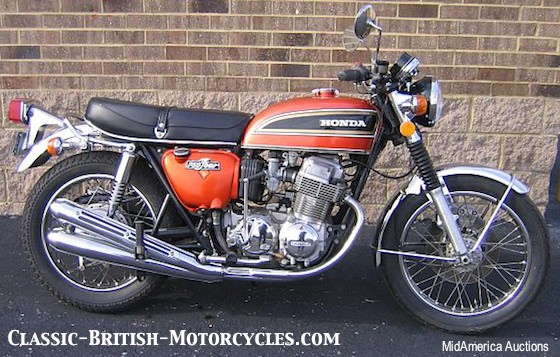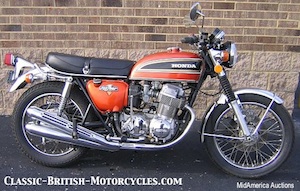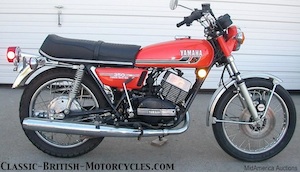Of all the Japanese Motorcycles ever produced, the Honda CB750 epitomizes the effect that they had on the British Motorcycle Industry. Total technical supremacy. And volume…the Brits could never hope to produce motorcycles in the sheer volumes of the combined might of Honda, Yamaha, Suzuki & Yamaha. Just when the American market was heating up with an appetite for motorcycles, the Brits were running out of steam & the Japanese Big 4 were just getting warmed up!
THE JAPANESE MOTORCYCLE & ITS IMPACT
ON THE BRITISH MOTORCYCLE INDUSTRY
JAPANESE MOTORCYCLES – OVERCONFIDENCE IN BRITAIN
No study of Classic British Motorcycles, or the British Motorcycle Industry as a whole, would be complete without an examination of the Japanese Motorcycle Industry and the motorcycles they produced. Because it was the Japanese Motorcycle, especially Honda, that truly devastated the Brits. As a whole, the British motorcycle manufacturers were holding on to ancient designs, mostly parallel twins designed in the mid-1940s or earlier, not just as a means of saving money (although this was certainly a major consideration), but also as the manifestation of a design philosophy. They believed in sticking with a time-proven design, then slowly developing & refining it over decades. Having been designed around World War II, their engineering reflected the manufacturing methods, the machine tools available & the materials commonly used in those days. Hence the vertically-split crankcases made separate from the primary & gearbox cases (non-unit construction), and the cast-iron cylinder blocks. These designs were still fairly fresh in the 1950s & the British marques flourished, both in the marketplace and on the track. Names like Triumph, BSA, and Norton, were becoming commonly known. The Triumph 650 Bonneville was widely regarded as one of the fastest bikes money could buy, unless you were rich enough to afford a Vincent Black Shadow.
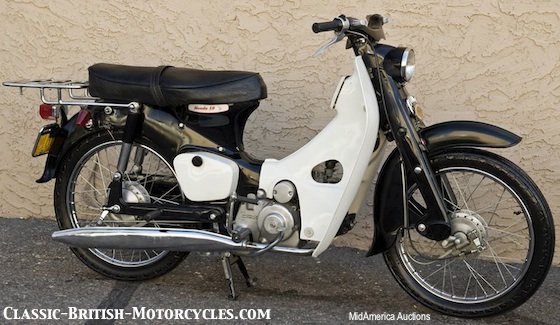
1963 Honda 50
JAPANESE MOTORCYCLES – TIMES ARE A’CHANGING
Honda broke into the US market in 1959 with its Honda 50. In 1960, the legendary designer of the Ariel Square 4 & the Triumph Speed Twin, Edward Turner, now on the Board of Directors for BSA (at the time, the largest motorcycle manufacturer in the world, consisting of BSA, Triumph, Ariel, James & Francis-Barnett), took an extended vacation in Japan to learn about the Motorcycle Industry there. He tours their factories and sees that the Japanese are poised to produce almost 750,000 motorcycles annually & they are just getting rolling. In contrast, Triumph, Britain’s largest single motorcycle brand, only produced 27,000 bikes total on their best year ever. Turner observed all this, then went home to England and changed nothing! Apparently, the conclusions he drew were that the British Motorcycle Industry was doing fine the way it was & should stay the course. He didn’t take the Japanese threat seriously, relegating them to building small, cheap, odd-looking utilitarian tiddlers for the Third World. The implications of their American marketing efforts started the year before must have eluded him.
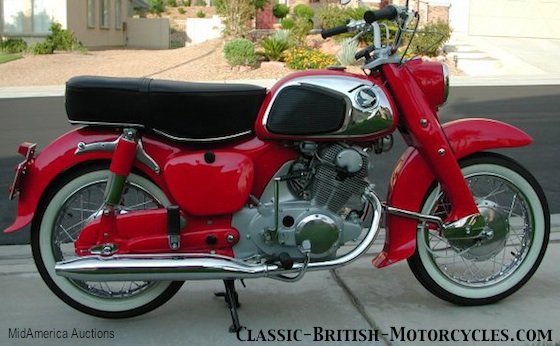
1961 Honda C77 Dream
JAPANESE MOTORCYCLES – TRYING TO FIND THEIR WAY
In 1960, the Japanese people were just 15 years from having been crushed in WWII. They are a proud people, but they somehow transformed their militaristic tendencies into industrial might & focused single-minded as a nation on rebuilding their nation & becoming a world-class economy. They weren’t messing around. And they weren’t looking to hold on to the old ways, either. The war has swept all of that away. Today was a new dawn, with new technologies & new markets. And no one more quicker to recognize this & capitalize on it than Soichiro Honda. Always looking forward, he wasn’t content to just sell 50cc Put-Puts with step-through frames. Honda had much grander ambitions. So, Honda Motorcycles began expanding its product line with the U.S. Market as its target. At first, the world watched with curiosity. And some of those early models were a little…’curious’. Take the lumpy Honda Dream, for instance. It’s hard to imagine today that anyone would have thought it was pretty, or desirable. The Japanese just didn’t know. They hadn’t yet figured out America’s tastes. Just look at the cars they were shipping over here, at the time. They were hopelessly out of touch with the American market, yet they still managed to gain some traction. The Honda Dreams sold well enough to show America that Honda knew how to build a decent middleweight motorcycle. And in fact, the little 305 twin performed enough to shame more than a few contemporary British 500s.

1967 Yamaha YDS-3
JAPANESE MOTORCYCLES – FINDING THEIR WAY
The rest of the Japanese Motorcycle Industry was quick to catch on & capitalize on Honda’s success, and in particular on this new beachhead that Honda had just established in America, in 1959. Yamaha, a manufacturer of fine musical instruments had actually beat Honda to the U.S. by a year (1958), but sold its only two models through an independent distributor under the “Cooper” name. But in 1960 Yamaha opened its own US Distributorship. Suzuki, a large textile loom manufacturer who had moved from motorized bicycles to small motorcycles, established their US Operation in 1963. Kawasaki Heavy Industries, makers of ships, trains & planes (really!) started building motorcycles in the 1950s & by the early 60s were shipping bikes to America. All the big players were now in the game. Their ideas of what Americans would like weren’t always very accurate & strike us as a little odd today. But remember what European motorcycles looked like in the late 1950s. They weren’t much better. At least the Japanese were willing to take chances, and they could afford to. A luxury that wasn’t available to motorcycle manufacturers from just about anywhere else in the world, at that time.

1966 Honda 450 KO “Black Bomber”
JAPANESE MOTORCYCLES – STARTING TO GET IT TOGETHER
It’s interesting to look at the contrasts between how the Japanese viewed the Motorcycle Business, and how the British Motorcycle Industry did. The Japanese were quick to catch their mistakes & correct them, then learn from them & make better choices next time. The Brits just kept rehashing the same old stuff with different paint colors & fancy names (ie: BSA Golden Flash, et al) & instead justify what they were doing. They refused to embrace the changing market conditions. They became victims of them, while the Japanese Motorcycle Industry became the architects of it. By the mid-1960s, the Japanese Big 4 were starting to figure things out, what Americans liked & wanted, what they would buy & what they wouldn’t. Japanese Motorcycles gained in size, displacement & power, and began looking more ‘like a motorcycle’. Only Honda was producing 4-stroke motorcycles for the US mass market. Yamaha, Suzuki & Kawasaki were all still concentrating on simpler, cheaper-to-build 2-strokes. But even these were looking more substantial & beginning to sell well in the American market. And when these bigger, better Japanese Motorcycles proved themselves to be fast & powerful, the horsepower race was on, with newer, bigger & faster designs coming out of the Japanese Big 4 with every new model year. The Brits were hopelessly outclassed by this point, having to rely on their antiquated 1940s designs. Still, 350cc was about as big as any Japanese bike got prior to about 1965. Then Honda broke the mold (again) with the radically-high tech DOHC 450 “Black Bomber”. Here, for the first time, was a Japanese motorcycle with enough power & displacement to rival just about any motorcycle in the world! The free-revving 450 twin easily bested 650 Triumph Bonnevilles and Nortons. The handwriting was on the wall.
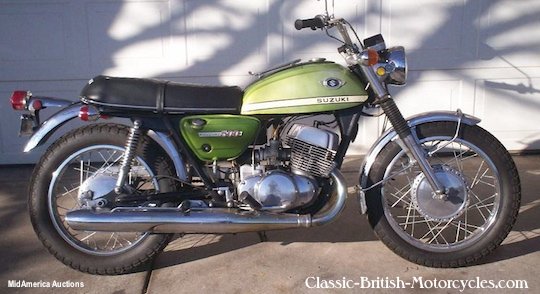
1970 Suzuki 500 Titan
JAPANESE MOTORCYCLES – THEY CONSOLIDATE THEIR DOMINANCE
Throughout the late 1960s, the Classic British Motorcycle Industry continued to thrive, but things were changing. The Japanese were now producing ever bigger, ever better & ever faster motorcycles. They weren’t very well regarded for their handling yet, but in terms of straight-line acceleration, there was nothing else that could touch them. They began looking more like macho motorcycles for crazy Americans, rather than odd-looking utilitarian commuters meant for the Third World. And what’s more, they were reliable, something that neither the Europeans, the Brits or Harley-Davidson could say at the time. Japanese Motorcycles had hit the mass market, we’d call it ‘going viral’ today.
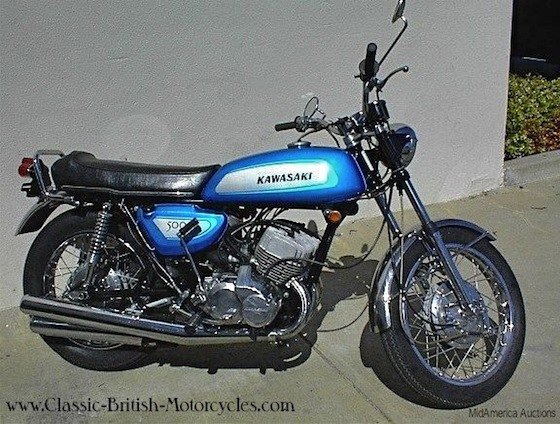
1970 Kawasaki 500 Mach3
JAPANESE MOTORCYCLES – ABSOLUTE SUPREMACY
By the close of the 1960s, the British Motorcycle Industry, already a shadow of its former once-mighty self, was now on the ropes. Harley-Davidson was struggling to survive. Few Americans had ever seen a European bike. But for the Japanese Motorcycle Industry, business was booming, and expanding in all directions. The Japanese Big 4 were now producing small bikes, lightweights, middleweights, heavyweights & dirt bikes. And with every successive model year, more and more models, with greater and greater displacements & more and more power. In 1969, Honda came out with its game-changing CB750 4-cylinder, and Kawasaki introduced the first of their radical 2-stroke triples, the 500cc Mach 3. It was so fast that it was dangerous. Of course, the handling on the early bikes wasn’t very good. But, in a straight line, there was nothing that could touch them. And once the Mach 3 got out front, the choking cloud of white smoke disoriented its prey. These bikes created the wheelie craze.
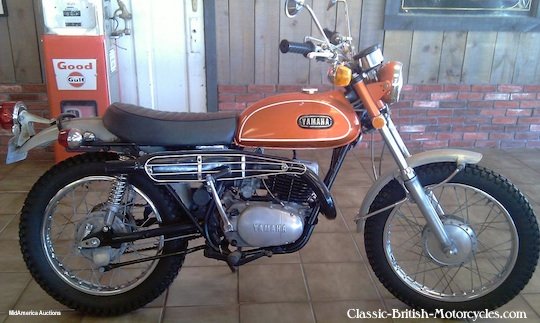
1971 Yamaha TD-1 250 Enduro
JAPANESE MOTORCYCLES – BREADTH OF MARKET
By 1971, only Triumph, BSA, and Norton remain, essentially hand-building a small range of street bikes in very low volumes. They had effectively abandoned the off-road market which they had helped to create with bikes like the BSA Gold Star and the Triumph Tiger, at a time when the off-road market was absolutely exploding! I grew up in this era, and everyone had a dirt bike. Suzuki 185s, Yamaha 250s (like the one above) & Kawasaki Green Streaks filled the high school parking lot. The Japanese had found yet another market to dominate, and they were very good at it. Most were 2-stroke, air-cooled singles, which were very simple & cheap to produce, and didn’t need to adhere to all the same safety & emissions rules as street bikes. In other words: Big Profits on lots and lots of dirt bikes. Even Honda got into the act with its first 2-stroke, the Honda 250 Elsinor, one of the best dirtbikes of the pre-monoshock era.
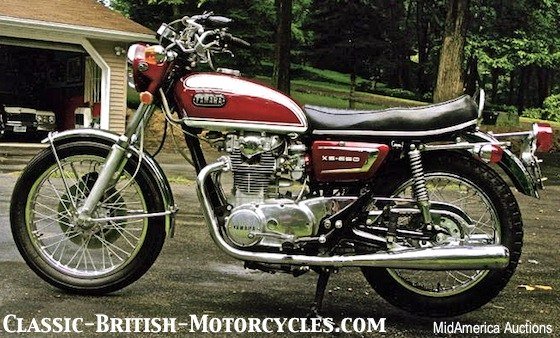
1972 Yamaha XS650
JAPANESE MOTORCYCLES – ADD INSULT TO INJURY
By 1973, BSA had died, Norton bought Triumph, and both struggled to build a few thousands bikes a year for what appeared to be a dwindling market for parallel twins. Somehow, Yamaha didn’t get the message, because in 1972, they introduced their take on the vertical twin, the Yamaha XS650. It was OHC, had center crankshaft support, was beautifully engineered & built. It was everything the British twins should have been, but better. It was an instant hit. It seemed the Japanese Motorcycle Manufacturers could do no wrong…and that the Brits could do no right. Within a few years, all motorcycle production in England would cease. The Japanese never looked back.
Japanese Motorcycles MAKE-BY-MAKE
Honda, the company that changed the world. US launch in 1959 with 50cc step-throughs, moved up to 305 Dreams & Superhawks, graduated to the 450 Black Bomber, then stunned with world with its game-changing CB750 4-cylinder. Still the technology leader today.
The musical instrument maker-turned motorcycle manufacturer. Yamaha used it precision design & engineering expertise, honed in the making of fine musical instruments to create one of the world’s most exciting & versatile motorcycle lines. Scrapped their way to the top in the US from humble beginnings.
Starting out in the early 20th century as a textile loom maker, by the 1950s it was motorized bicycles, then small motorcycles. Came to the US in 1963 & became a household name. In the 1980s, they became a performance leader with bikes like the Katana, Hiyabusa & the GSX1100R.
Part of Kawasaki heavy industries, makers of ships, trains, planes & more. Moved into motorcycle production in 1950s & followed Honda to America in early 1960s. Introduced the 500cc Mach 3 2-stroke triple, probably the fastest motorcycle of its day. The fun never stopped!


